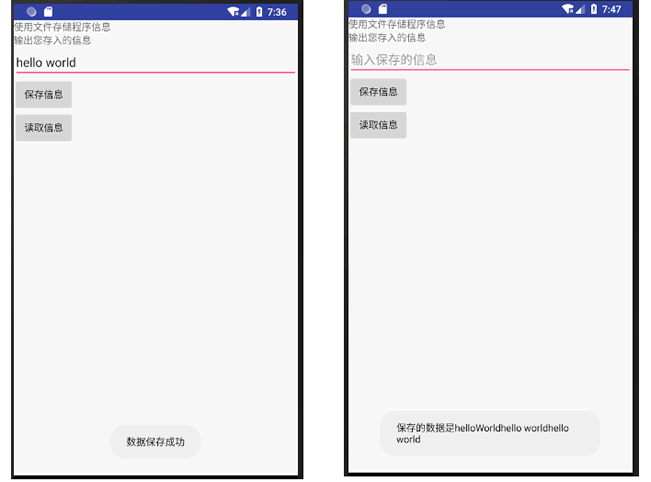Android数据存储之文件存储
Android的文件存储方式分为两种:内部存储和外部存储。
当创建的应用程序被卸载时,其内部存储的文件也随之被删除。当内部存储器的存储空间不足时,缓存文件可能会被删除以释放空间。
因此,缓存文件是不可靠的。当使用缓存文件时,自己应该维护好缓存文件,并且将缓存文件限制在特定大小之内。
使用文件存储信息时,使用 openFileOutput 和 openFileInput 进行文件的读写,这跟 Java 中的 I/O 程序很类似。创建并写内部存储文件的步骤如下:
1)通过 Context.openFileOutput(String name, int mode) 方法打开文件并设定读写方式,返回 FileOutputStream。
其中,参数 mode 取值为:
3) 调用 FileOutputStream.close() 方法关闭输出流,完成写操作。
内部存储文件的写文件示例代码如下:
外部存储的文件不被某个应用程序所特有,可以被其他应用程序共享,当将该外部存储设备连接到计算机上时,这些文件可以被浏览、修改和删除。因此,这种存储方式不具有安全性。
由于外部存储器可能处于被移除、连接到计算机、丢失、只读或者其他各种状态,因此在使用外部存储之前,必须使用 Environment.getExternalStorageState() 方法来确认外部存储器是否可用。
验证外部存储器是否可读写的代码如下:
如上述一样,当存储器的存储空间不足时,缓存文件可能会被删除以释放空间。因此,缓存文件是不可靠的。当使用缓存文件时,应该自己维护好缓存文件,并且将缓存文件限制在特定大小之内。

图 1 FileDemo运行结果
该实例将文本框中输入的内容存储到名为 text 的文件中。当该应用程序再次启动时,可以从 text 文件写入的内容中读取并显示出来。
本实例使用内部存储方式,我们可以在 data/data/<your package name>/files 目录下找到名为 text 的文件。
本实例没有将文件放置到 SD卡 中,可自行实现将文件保存在 SD 卡中的操作。
实例 FileDemo 的布局文件 main.xml 中放置了两个 TextView、一个 EditText 和两个 Button,其代码如下:
1) 内部存储
内部存储是指将应用程序的数据以文件方式存储到设备内存中。以内部存储方式存储的文件属于其所创建的应用程序私有,其他应用程序无权进行操作。当创建的应用程序被卸载时,其内部存储的文件也随之被删除。当内部存储器的存储空间不足时,缓存文件可能会被删除以释放空间。
因此,缓存文件是不可靠的。当使用缓存文件时,自己应该维护好缓存文件,并且将缓存文件限制在特定大小之内。
使用文件存储信息时,使用 openFileOutput 和 openFileInput 进行文件的读写,这跟 Java 中的 I/O 程序很类似。创建并写内部存储文件的步骤如下:
1)通过 Context.openFileOutput(String name, int mode) 方法打开文件并设定读写方式,返回 FileOutputStream。
其中,参数 mode 取值为:
- MODE_PRIVATE:默认访问方式,文件仅能被创建应用程序访问。
- MODE_APPEND:若文件已经存在,则在文件末尾继续写入数据,而不抹掉文件原有内容。
- MODE_WORLD_READABLE:允许该文件被其他应用程序执行读取内容操作。
- MODE_WORLD_WRITEABLE:允许该文件被其他应用程序执行写操作。
3) 调用 FileOutputStream.close() 方法关闭输出流,完成写操作。
内部存储文件的写文件示例代码如下:
String FILENAME="hello_file"; String string="hello world"; FileOutputStream fos = openFileOutput(FILENAME,Context.MODE_PRIVATE); fos.write(string.getBytes()); fos.close();
2) 外部存储
外部存储是指将文件存储到一些外部存储设备上。例如 SD 卡或者设备内嵌的存储卡,属于永久性的存储方式。外部存储的文件不被某个应用程序所特有,可以被其他应用程序共享,当将该外部存储设备连接到计算机上时,这些文件可以被浏览、修改和删除。因此,这种存储方式不具有安全性。
由于外部存储器可能处于被移除、连接到计算机、丢失、只读或者其他各种状态,因此在使用外部存储之前,必须使用 Environment.getExternalStorageState() 方法来确认外部存储器是否可用。
验证外部存储器是否可读写的代码如下:
boolean mExternalStorageAvailable=false;
boolean mExternalStorageWriteable=false;
String state = Environment.getExternalStorageState();
if(Environment.MEDIA_MOUNTED.equals(state)){
//外部存储器可读写
mExternalStorageAvailable = mExternalStorageWriteable = true;
}else if(Environment.MEDIA_MOUNTED_READ_ONLY.equals(state)){
//外部存储器可读不可写
mExternalStorageAvailable=true;
mExternalStorageWriteable=false;
}else{
//外部存储器不可读写,处于其他状态
mExternalStorageAvailable = mExternalStorageWriteable = false;
}
此外,在程序开发过程中还可以使用缓存文件(Cache),内部存储和外部存储都可以用于保存缓存文件。如上述一样,当存储器的存储空间不足时,缓存文件可能会被删除以释放空间。因此,缓存文件是不可靠的。当使用缓存文件时,应该自己维护好缓存文件,并且将缓存文件限制在特定大小之内。
使用文件存储功能
实例 FileDemo 演示了使用文件存储的功能,其运行效果如图 1 所示。
图 1 FileDemo运行结果
该实例将文本框中输入的内容存储到名为 text 的文件中。当该应用程序再次启动时,可以从 text 文件写入的内容中读取并显示出来。
本实例使用内部存储方式,我们可以在 data/data/<your package name>/files 目录下找到名为 text 的文件。
本实例没有将文件放置到 SD卡 中,可自行实现将文件保存在 SD 卡中的操作。
实例 FileDemo 的布局文件 main.xml 中放置了两个 TextView、一个 EditText 和两个 Button,其代码如下:
<?xml version="1.0" encoding="utf-8"?>
<LinearLayout xmlns:android="http://schemas.android.com/apk/res/android"
android:layout_width="fill_parent"
android:layout_height="fill_parent"
android:orientation="vertical">
<TextView
android:layout_width="fill_parent"
android:layout_height="wrap_content"
android:text="使用文件存储程序信息" />
<TextView
android:layout_width="fill_parent"
android:layout_height="wrap_content"
android:text="输出您存入的信息" />
<EditText
android:id="@+id/phone_text"
android:layout_width="fill_parent"
android:layout_height="wrap_content"
android:hint="输入保存的信息" />
<LinearLayout
android:layout_width="wrap_content"
android:layout_height="wrap_content"
android:orientation="vertical">
<Button
android:id="@+id/SaveButton"
android:layout_width="wrap_content"
android:layout_height="wrap_content"
android:text="保存信息" />
<Button
android:id="@+id/LoadButton"
android:layout_width="wrap_content"
android:layout_height="wrap_content"
android:text="读取信息" />
</LinearLayout>
</LinearLayout>
实例 FileDemo 中 AndroidManifest.xml 文件的代码如下:
<?xml version="1.0" encoding="utf-8"?>
<manifest xmlns:android="http://schemas.android.com/apk/res/android"
package="introduction.android.fileDemo"
android:versionCode="1"
android:versionName="1.0">
<uses-sdk android:minSdkVersion="14" />
<application
android:allowBackup="true"
android:icon="@mipmap/ic_launcher"
android:label="@string/app_name"
android:roundIcon="@mipmap/ic_launcher_round"
android:supportsRtl="true"
android:theme="@style/AppTheme">
<activity android:name=".MainActivity">
<intent-filter>
<action android:name="android.intent.action.MAIN" />
<category android:name="android.intent.category.LAUNCHER" />
</intent-filter>
</activity>
</application>
</manifest>
实例 FileDemo 中 MainActivity.java 的代码如下:
import android.app.Activity;
import android.os.Bundle;
import android.view.View;
import android.widget.Button;
import android.widget.EditText;
import android.widget.Toast;
import java.io.FileInputStream;
import java.io.FileOutputStream;
public class MainActivity extends Activity {
private EditText SaveText;
private Button SaveButton, LoadButton;
@Override
public void onCreate(Bundle savedInstanceState) {
super.onCreate(savedInstanceState);
setContentView(R.layout.activity_main);
SaveText = (EditText) findViewById(R.id.phone_text);
SaveButton = (Button) findViewById(R.id.SaveButton);
LoadButton = (Button) findViewById(R.id.LoadButton);
SaveButton.setOnClickListener(new ButtonListener());
LoadButton.setOnClickListener(new ButtonListener());
}
private class ButtonListener implements View.OnClickListener {
@Override
public void onClick(View v) {
switch (v.getId()) {
/*保存数据*/
case R.id.SaveButton:
String saveinfo = SaveText.getText().toString().trim();
FileOutputStream fos;
try {
fos = openFileOutput("text", MODE_APPEND);
fos.write(saveinfo.getBytes());
fos.close();
} catch (Exception e) {
e.printStackTrace();
}
Toast.makeText(MainActivity.this, "数据保存成功", Toast.LENGTH_LONG).
show();
break;
/*读取数据*/
case R.id.LoadButton:
String get = "";
try {
FileInputStream fis = openFileInput("text");
byte[] buffer = new byte[fis.available()];
fis.read(buffer);
get = new String(buffer);
} catch (Exception e) {
e.printStackTrace();
}
Toast.makeText(MainActivity.this, "保存的数据是" + get,
Toast.LENGTH_LONG).show();
break;
default:
break;
}
}
}
}
所有教程
- C语言入门
- C语言编译器
- C语言项目案例
- 数据结构
- C++
- STL
- C++11
- socket
- GCC
- GDB
- Makefile
- OpenCV
- Qt教程
- Unity 3D
- UE4
- 游戏引擎
- Python
- Python并发编程
- TensorFlow
- Django
- NumPy
- Linux
- Shell
- Java教程
- 设计模式
- Java Swing
- Servlet
- JSP教程
- Struts2
- Maven
- Spring
- Spring MVC
- Spring Boot
- Spring Cloud
- Hibernate
- Mybatis
- MySQL教程
- MySQL函数
- NoSQL
- Redis
- MongoDB
- HBase
- Go语言
- C#
- MATLAB
- JavaScript
- Bootstrap
- HTML
- CSS教程
- PHP
- 汇编语言
- TCP/IP
- vi命令
- Android教程
- 区块链
- Docker
- 大数据
- 云计算